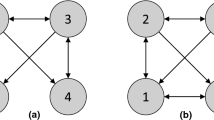Abstract
We describe statistical models for detecting causality between two events. Our models are kinds of latent variable models, actually expanded versions of the existing statistical co-occurrence models. The (statistical) dependency information between two events needs to be incorporated into causal models. We handle this information via latent variables in our models. Through experiments, we achieved .678 F-measure value for the evaluation data.
Preview
Unable to display preview. Download preview PDF.
Similar content being viewed by others
References
Allen, J.F.: Recognizing intentions from natural language utterances. In: Brady, M., Berwick, R.C. (eds.) Computational models of discourse, MIT Press, Cambridge (1983)
Chang, D.-S., Choi, K.-S.: Causal relation extraction using cue phrase and lexical pair probabilities. In: Proceedings of the 1st International Joint Conference of Natural Language Processing (IJCNLP-2004), pp. 61–70 (2004)
Church, K.W., Hanks, P.: Word association norms, mutual information, and lexicography. In: Proceedings of the 27th. Annual Meeting of the Association for Computational Linguistics (ACL-1989), pp. 76–83 (1989)
Cooper, G., Heckerman, D., Meek, C.: A Bayesian approach to causal discovery. Technical report, Microsoft Research Advanced Technology Division, Microsoft Corporation, Technical Report MSR-TR-97-05 (1997)
Dempster, A.P., Laird, N.M., Rubin, D.B.: Maximum likelihood from incomplete data via the EM algorithm. Journal of the Royal Statistical Society, Series B 34, 1–38 (1977)
Fellbaum, C.: WordNet: An Electronic Lexical Database. MIT Press, Cambridge (1998)
Garcia, D.: COATIS, an NLP system to locate expressions of actions connected by causality links. In: Proceedings of The 10th European Knowledge Acquisition Workshop, pp. 347–352 (1997)
Girju, R.: Automatic detection of causal relations for question answering. In: Proceedings of Annual Meeting of the Association for Computational Linguistics, Workshop on Multilingual Summarization and Question Answering - Machine Learning and Beyond (2003)
Girju, R., Moldovan, D.: Mining answers for causation questions. In: Proc. The AAAI Spring Symposium on Mining Answers from Texts and Knowledge Bases (2002)
Hobbs, J.R.: Coherence and co-reference. Cognitive Science 1, 67–82 (1979)
Hobbs, J.R.: On the coherence and structure of discourse. Technical report, Technical Report CSLI-85-37, Center for The Study of Language and Information (1985)
Hofmann, T.: Unsupervised learning by probabilistic latent semantic analysis. Machine Learning Journal 42(1), 177–196 (2001)
Hofmann, T., Puzicha, J.: Statistical models for co-occurrence data. Technical Report AIM-1625, Artificial Intelligence Laboratory, MIT (1998)
Inui, T., Inui, K., Matsumoto, Y.: What kinds and amounts of causal knowledge can be acquired from text by using connective markers as clues? In: Grieser, G., Tanaka, Y., Yamamoto, A. (eds.) DS 2003. LNCS (LNAI), vol. 2843, pp. 180–193. Springer, Heidelberg (2003)
Inui, T., Okumura, M.: Investigating the characteristics of causal relations in Japanese text. In: Proceedings of Annual Meeting of the Association for Computational Linguistics, Workshop on Frontiers in Corpus Annotation II: Pie in the Sky, pp. 37–44 (2005)
Khoo, C.S.G., Chan, S., Niu, Y.: Extracting causal knowledge from a medical database using graphical patterns. In: Proceedings of The 38th. Annual Meeting of The Association for Computational Linguistics (ACL-2000), pp. 336–343 (2000)
Mainichi. Mainichi Shimbun CD-ROM version (1995)
Mitchell, T.: Machine Learning. McGraw-Hill, New York (1997)
Nigam, K., McCallum, A.K., Thrun, S., Mitchell, T.M.: Text classification from labeled and unlabeled documents using EM. Machine Learning 39(2/3), 103–134 (2000)
Pearl, J.: Causality: Models, Reasoning, and Inference. Cambridge Universiy Press, Cambridge (2000)
Pei, J., Han, J., Mortazavi-Asi, B., Pinto, H., Chen, Q., Dayal, U., Hsu, M.-C.: PrefixSpan: mining sequential patterns efficiently by prefix projected pattern growth. In: Proceedings of 1st Conference of Data Enginnering (ICDE-2001), pp. 215–226 (2001)
Pustejovsky, J.: The Generative Lexicon. MIT Press, Cambridge (1995)
Sanchez-Graillet, O., Poesio, M.: Acquiring bayesian networks from text. In: Proceedings of the 4th International Conference on Language Resources and Evaluation (LREC-2004), pp. 955–958 (2004)
Terada, A.: A Study of Text Mining Techniques Using Natural Language Processing. PhD thesis, Tokyo Institute of Technology (2003)
Torisawa, K.: An unsupervised learning method for commonsensical inference rules on events. In: Proceedings of the Second CoLogNet-ElsNET Symposium, pp. 146–153 (2003)
U.S. National Library of Medicine: The MEDLINE database (2001), see also, http://www.ncbi.nlm.nih.gov/PubMed/
Vapnik, V.N.: The Nature of Statistical Learning Theory. Springer, Heidelberg (1995)
Zhang, N.L., Nielsen, T.D., Jensen, F.V.: Latent variable discovery in classification models. Artificial Intelligence in Medicine 30(3), 283–299 (2004)
Author information
Authors and Affiliations
Editor information
Rights and permissions
Copyright information
© 2007 Springer-Verlag Berlin Heidelberg
About this paper
Cite this paper
Inui, T., Takamura, H., Okumura, M. (2007). Latent Variable Models for Causal Knowledge Acquisition. In: Gelbukh, A. (eds) Computational Linguistics and Intelligent Text Processing. CICLing 2007. Lecture Notes in Computer Science, vol 4394. Springer, Berlin, Heidelberg. https://doi.org/10.1007/978-3-540-70939-8_8
Download citation
DOI: https://doi.org/10.1007/978-3-540-70939-8_8
Publisher Name: Springer, Berlin, Heidelberg
Print ISBN: 978-3-540-70938-1
Online ISBN: 978-3-540-70939-8
eBook Packages: Computer ScienceComputer Science (R0)



